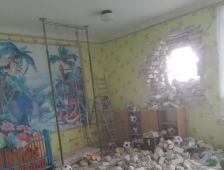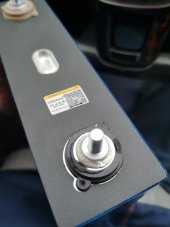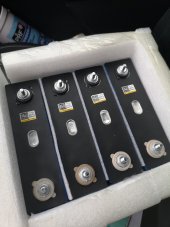Best to take any offer. Be fair about it.Yes it is so that 2 cells have a lower capacity, another test done and still a capacity is 55ah. Cell voltage after test. 2.747 + 2.713 + 3.079 + 3.044.
Next I do a test for each cell, after that I try to get a refund for the price, probably useless what I’ve read, I still try.
You are using an out of date browser. It may not display this or other websites correctly.
You should upgrade or use an alternative browser.
You should upgrade or use an alternative browser.
Top Balancing "How to"
- Thread starter snoobler
- Start date
Hedges
I See Electromagnetic Fields!
- Joined
- Mar 28, 2020
- Messages
- 20,694
Those were "90 Ah" cells, and you did parallel top-balance them to 3.6V, but pack only delivers 55 Ah before two cells go low voltage?
Are they even the same dimensions?? same weight?
If they contain same amount of material but have just 2/3 the capacity, something must be really wrong inside. Wouldn't count on them being reliable and delivering expected cycle life.
Are they even the same dimensions?? same weight?
If they contain same amount of material but have just 2/3 the capacity, something must be really wrong inside. Wouldn't count on them being reliable and delivering expected cycle life.
Externally all similar re-wrapped, the weight I have not checked. One cell already had traces of heat in the plus-pole, the plastic of the negative terminal is also different in color than the others (pic). The cells were 3.29v when they came to me. After the parallel connection they were well balanced, before the test 3,586-3,602v but cells 1 and 2 drop faster than 3 and 4. When the first cell reached 2.5v the result showed 55ah.
Attachments
Hedges
I See Electromagnetic Fields!
- Joined
- Mar 28, 2020
- Messages
- 20,694
Heat discoloration as-received, before you used it?
I had forgotten, apparent low cell voltage (and failure to actually top balance) can occur due to poor contact.
After top balance and allowing them to sit, did you double-check voltage of cells individually?
It is possible they didn't get top balanced well. But, that should show up as low cell voltage according to BMS.
During operation with BMS, of poor contact in series connections, affected cells would get higher voltage during charging and lower voltage during discharging.
Can you poke a sharp DMM probe in to contact cell terminal itself, under busbar? Measure cell + to -, see what cell voltage actually is. Measure cell terminal to attached busbar with high current flowing, see if any have poor contact.
Aluminum oxide is a problem, needs to be scrubbed off and surface treated with corrosion inhibitor.
I had forgotten, apparent low cell voltage (and failure to actually top balance) can occur due to poor contact.
After top balance and allowing them to sit, did you double-check voltage of cells individually?
It is possible they didn't get top balanced well. But, that should show up as low cell voltage according to BMS.
During operation with BMS, of poor contact in series connections, affected cells would get higher voltage during charging and lower voltage during discharging.
Can you poke a sharp DMM probe in to contact cell terminal itself, under busbar? Measure cell + to -, see what cell voltage actually is. Measure cell terminal to attached busbar with high current flowing, see if any have poor contact.
Aluminum oxide is a problem, needs to be scrubbed off and surface treated with corrosion inhibitor.
Heat discoloration as-received, before you used it
I had forgotten, apparent low cell voltage (and failure to actually top balance) can occur due to poor contact.
After top balance and allowing them to sit, did you double-check voltage of cells individually?
It is possible they didn't get top balanced well. But, that should show up as low cell voltage according to BMS.
During operation with BMS, of poor contact in series connections, affected cells would get higher voltage during charging and lower voltage during discharging.
Can you poke a sharp DMM probe in to contact cell terminal itself, under busbar? Measure cell + to -, see what cell voltage actually is. Measure cell terminal to attached busbar with high current flowing, see if any have poor contact.
Aluminum oxide is a problem, needs to be scrubbed off and surface treated with corrosion inhibitor.
Heat discoloration as-received, before you used it?Heat discoloration as-received, before you used it?
I had forgotten, apparent low cell voltage (and failure to actually top balance) can occur due to poor contact.
After top balance and allowing them to sit, did you double-check voltage of cells individually?
It is possible they didn't get top balanced well. But, that should show up as low cell voltage according to BMS.
During operation with BMS, of poor contact in series connections, affected cells would get higher voltage during charging and lower voltage during discharging.
Can you poke a sharp DMM probe in to contact cell terminal itself, under busbar? Measure cell + to -, see what cell voltage actually is. Measure cell terminal to attached busbar with high current flowing, see if any have poor contact.
Aluminum oxide is a problem, needs to be scrubbed off and surface treated with corrosion inhibitor.
-Yes
After top balance and allowing them to sit, did you double-check voltage of cells individually?
It is possible they didn't get top balanced well. But, that should show up as low cell voltage according to BMS.
-After top balancing, i let the cells rest for 1.5 hours, I check the voltages with a dmm-probe, the voltages were as follows: (1) 3,602v (2) 3,607v (3) 3,593v (4) 3,596v then I did the test. The bms also showed the same readings.
During operation with BMS, of poor contact in series connections, affected cells would get higher voltage during charging and lower voltage during discharging.
Can you poke a sharp DMM probe in to contact cell terminal itself, under busbar? Measure cell + to -, see what cell voltage actually is. Measure cell terminal to attached busbar with high current flowing, see if any have poor contact.
Aluminum oxide is a problem, needs to be scrubbed off and surface treated with corrosion inhibitor.
-This could still be tried, but on the other hand, the truth about capacities comes out when I do the test on the cells separately.
Litikola has a reputation of selling old cells that are worn out.Perhaps I've missed something, but...
How are you testing them individually?
Why is the color variance of the cell terminal assumed to be 'heat discoloration'? Were these sold as used cells?
Are the cell QR codes valid?
One of his cells was obviously shorted, the bubbled plastic and scorch marks on the terminal are the "discoloration".
Does it matter if the cell QR code is valid with used cells that measure 55AH that are being sold as new 90AH?
Nope! Return them then.Litikola has a reputation of selling old cells that are worn out.
One of his cells was obviously shorted, the bubbled plastic and scorch marks on the terminal are the "discoloration".
Does it matter if the cell QR code is valid with used cells that measure 55AH that are being sold as new 90AH?
So you're claiming fraud?
Perhaps I've missed something, but...
How are you testing them individually?
Why is the color variance of the cell terminal assumed to be 'heat discoloration'? Were these sold as used cells?
Are the cell QR codes valid?
Each cell without bms to capasitytester?
"Brand new grade A" like aliexpress says ?
Hedges
I See Electromagnetic Fields!
- Joined
- Mar 28, 2020
- Messages
- 20,694
-This could still be tried, but on the other hand, the truth about capacities comes out when I do the test on the cells separately.
Yes, and also subject to contact resistance causing low-voltage disconnect. But less likely to follow same cells around (label them to keep track), unless it is excessive oxide on the cell terminals.
Did you ever try to deal with the native oxide?
It won't affect actual capacity if low, of course. But it can cause false capacity readings, and problems in operation.
Nope! Return them then.
"Brand new grade A" like aliexpress says ?
Use as artillery shell in a howitzer, return via airmail through the wall of their building.
(A reference to current events, of course)

No. Those are Litokala QR codes you see in the image and they do not manufacture cells. It looks like they have covered other labels with their own labels. Also all of the cells I have seen have the QR code etched into the aluminum on top of the cell and it is visible.Are the cell QR codes valid?
If you don't end up having to send them back it would be very telling if you could peel off the black on top of the cell and see if there is/was the original QR code there. Some sellers scratch it so we may not be able to tell who the manufacturer was."Brand new grade A" like aliexpress says
I see the discoloration and wonder if it could have been caused by initial poor targeting of the laser? Those look like laser welded studs to me.Heat discoloration as-received, before you used it?
This is possible, but what also strikes me is that the minus pole of that cell is a different color than the other cells, meaning that at least they are not the same batch.I see the discoloration and wonder if it could have been caused by initial poor targeting of the laser? Those look like laser welded studs to me.
Yes, i do that if i don't send them back.If you don't end up having to send them back it would be very telling if you could peel off the black on top of the cell and see if there is/was the original QR code there. Some sellers scratch it so we may
Now completed the tests for each cell one at a time without bms. I charged the cells one by one to 3.6v and set the DL24P Tester cutoff voltage to 2.6v. Results with 9A discharge current:
Cell1: 3.532-> 2.6v = 55ah
Cell2: 3.496-> 2.6v = 55ah
Cell3: 3.541-> 2.6v = 57ah
Cell4: 3.498-> 2.6v = 54ah
The cells rested for about 6 hours before the test (i.e., during the previous cell test). The result would be a little better with the 3.65-> 2.5v test, I don't know how much more capacity it gets? For safety reasons, I left the voltage range smaller.
Cell1: 3.532-> 2.6v = 55ah
Cell2: 3.496-> 2.6v = 55ah
Cell3: 3.541-> 2.6v = 57ah
Cell4: 3.498-> 2.6v = 54ah
The cells rested for about 6 hours before the test (i.e., during the previous cell test). The result would be a little better with the 3.65-> 2.5v test, I don't know how much more capacity it gets? For safety reasons, I left the voltage range smaller.
Hedges
I See Electromagnetic Fields!
- Joined
- Mar 28, 2020
- Messages
- 20,694
Seems like they are well matched 55 Ah cells. Sold as 90 Ah.
You could check size, weight, appearance against other advertised 55A and 90A cells.
Hope you have a mechanism to dispute and get a refund. I've read some people received refunds based on difference between actual and claimed capacity. Better that is for whole pack, than just a couple cells leaving less than a full pack.
You could check size, weight, appearance against other advertised 55A and 90A cells.
Hope you have a mechanism to dispute and get a refund. I've read some people received refunds based on difference between actual and claimed capacity. Better that is for whole pack, than just a couple cells leaving less than a full pack.
They may have even been pulled from the wrong bin or carton, or mis-marked/mis-labeled. That would not surprise me one bit.
Like a clerical error - it only takes one dummy to screw things up along the way. Or a stock puller takes them out of one carton and realizes they're the wrong ones and puts them into a different box/bin/group.
You now have documented proof of claim. Costs as much to send them back as they're worth.
Like a clerical error - it only takes one dummy to screw things up along the way. Or a stock puller takes them out of one carton and realizes they're the wrong ones and puts them into a different box/bin/group.
You now have documented proof of claim. Costs as much to send them back as they're worth.
They may have even been pulled from the wrong bin or carton, or mis-marked/mis-labeled. That would not surprise me one bit.
Like a clerical error - it only takes one dummy to screw things up along the way. Or a stock puller takes them out of one carton and realizes they're the wrong ones and puts them into a different box/bin/group.
You now have documented proof of claim. Costs as much to send them back as they're worth.
You really need to search the forum for the reputation of this company. This is not an "honest mistake".
Can anyone offer any insight to the theory that an adjustable power supply designed for ham radio might be able to be used to top balance? I have an adjustable MFJ-4230MVP, 4-16v, and with a multimeter have confirmed it adjust to 3.6v. It is a 30a power supply and figured it could be a way to top balance 16 280ah cells in parallel much faster than other inexpensive options. First, cost, is less as I already own it. Second is 30a seems like it would be much faster than 10a for the large battery.
Any insight helps! Thanks
Link to MFJ DC power supply
Any insight helps! Thanks
Link to MFJ DC power supply
Last edited:
Can anyone offer any insight to the theory that an adjustable power supply designed for ham radio might be able to be used to top balance? I have an adjustable MFJ-4230MVP, 4-16v, and with a multimeter have confirmed it adjust to 3.6a. It is a 30a power supply and figured it could be a way to top balance 16 280ah cells in parallel much faster than other inexpensive options. First, cost, is less as I already own it. Second is 30a seems like it would be much faster than 10a for the large battery.
Any insight helps! Thanks
Link to MFJ DC power supply

Top Balancing LiFePo4 Cells using a low cost benchtop power supply.
To get the paper, click on the orange at the top of this page. This is a tutorial with detailed steps on how I top-balance my LiFePO4 Cells using a low-cost benchtop power supply. To get the tutorial, click on the orange "Download" button...
As long as it goes down to 3.65 VOLTS (not amps). Read the link above, best to hook them up in series and charge as a pack first, WITH A BMS.
When the BMS triggers a high cell voltage disconnect, then parallel and finish top balancing.
It's explained in the link above (3 - Pre-charging the cells to get them ‘mostly’ charged. ).
@FilterGuy did a good job writing that, ask if you have more questions.
Charging in series first WITH A BMS is much faster. I assume you have a BMS, since not many people have a need for a 3.2v battery.
John, thanks for the reply. @FilterGuy ’s guide is what made think about considering the MFJ power supply. And yes, confirming the 3.65v at up to 30a. I have hooked up the cells in 16s and charged with JBD BMS. One of the cells runs away when trying to charge, tripping the over current protection. So I cycled twice to watch the voltages during charge and discharge. The series balances really well at rest, but struggles on the charge past 3.4 volts, as one cell skyrockets.
Top Balancing LiFePo4 Cells using a low cost benchtop power supply.
To get the paper, click on the orange at the top of this page. This is a tutorial with detailed steps on how I top-balance my LiFePO4 Cells using a low-cost benchtop power supply. To get the tutorial, click on the orange "Download" button...diysolarforum.com
As long as it goes down to 3.65 VOLTS (not amps). Read the link above, best to hook them up in series and charge as a pack first, WITH A BMS.
When the BMS triggers a high cell voltage disconnect, then parallel and finish top balancing.
It's explained in the link above (3 - Pre-charging the cells to get them ‘mostly’ charged. ).
@FilterGuy did a good job writing that, ask if you have more questions.
Charging in series first WITH A BMS is much faster. I assume you have a BMS, since not many people have a need for a 3.2v battery.
@Just John, thank you for your time and ref to the guide. It’s a good one!
Similar threads
- Replies
- 4
- Views
- 569
- Replies
- 258
- Views
- 13K
- Replies
- 13
- Views
- 616
- Replies
- 1
- Views
- 380
- Replies
- 8
- Views
- 310





